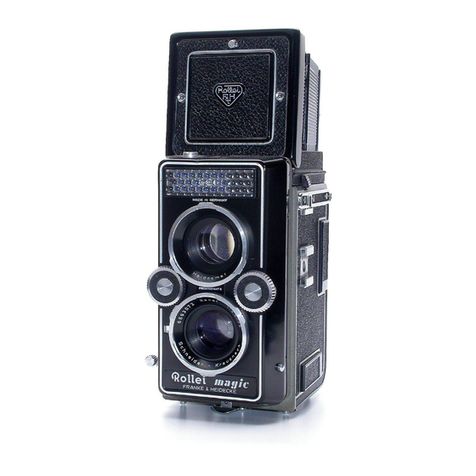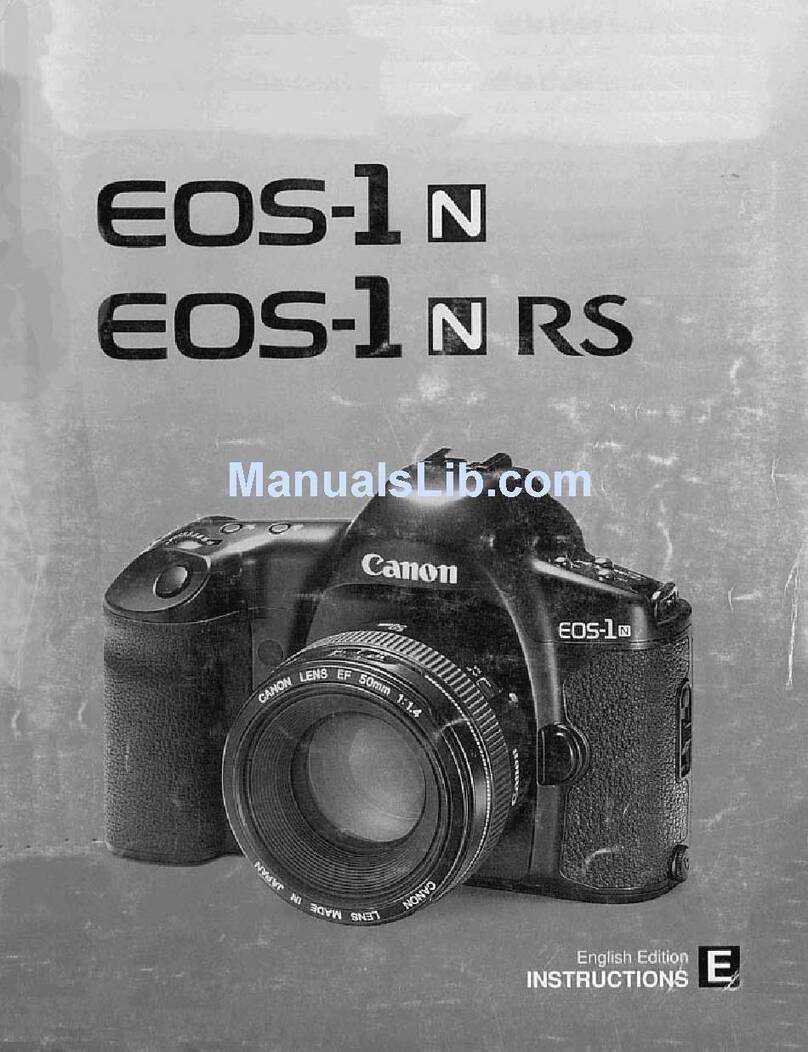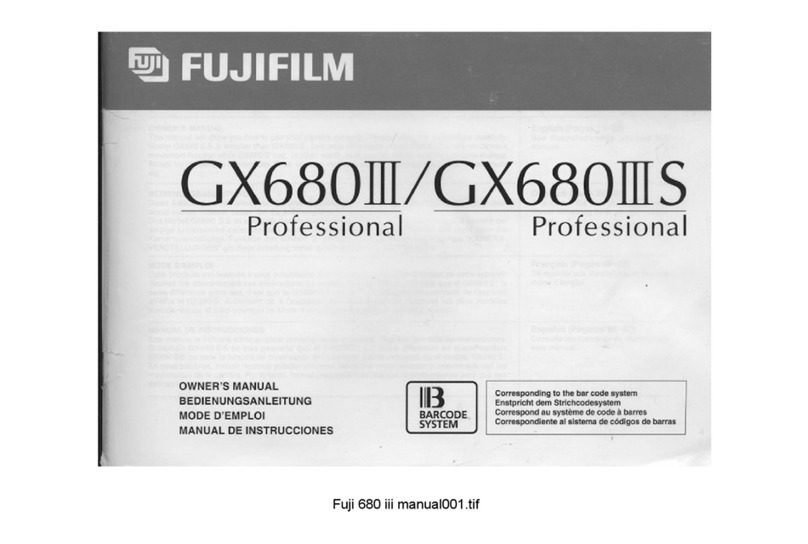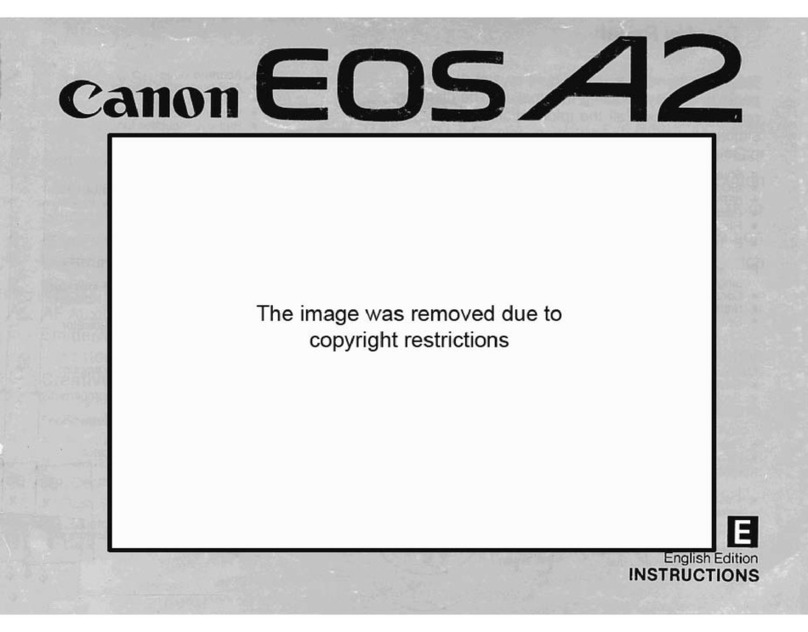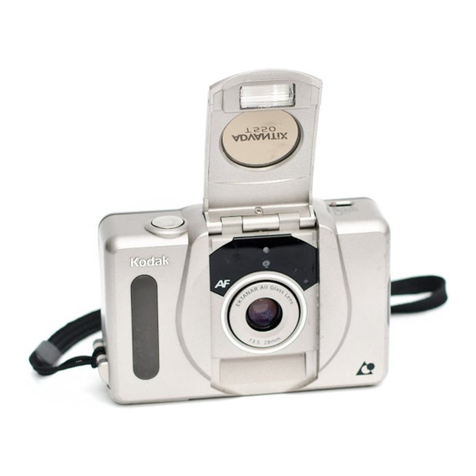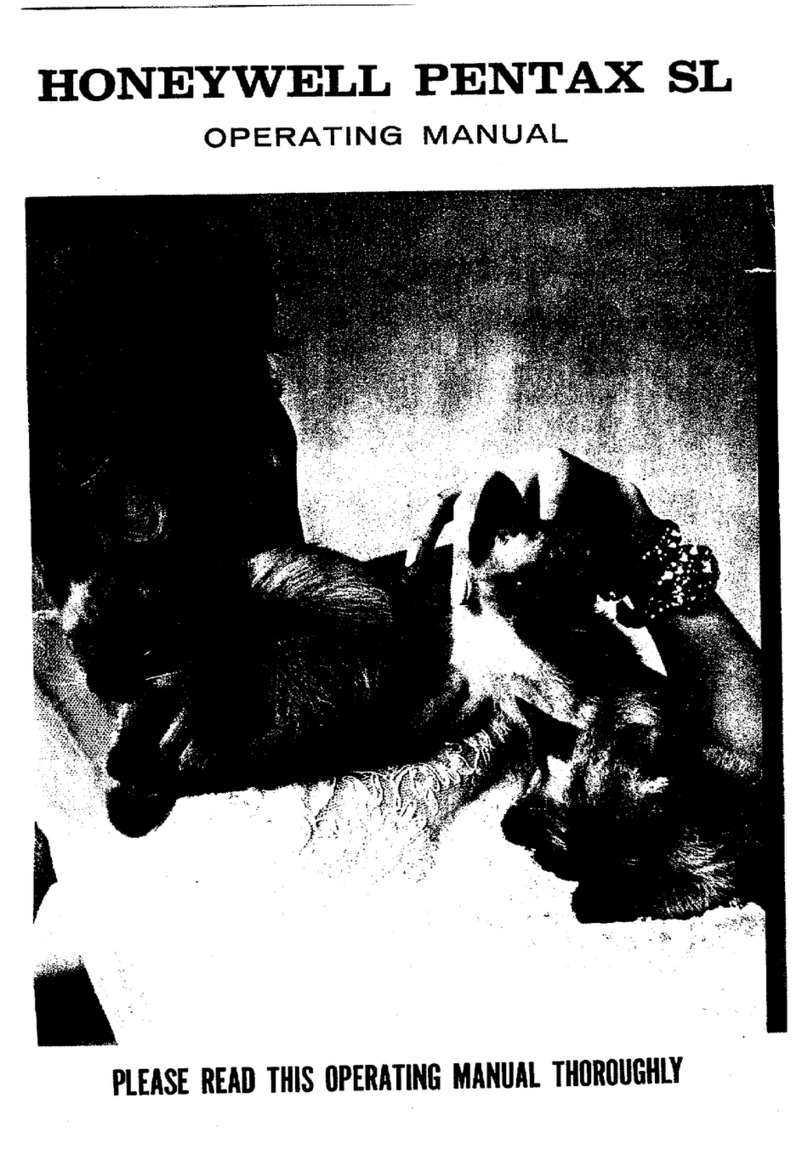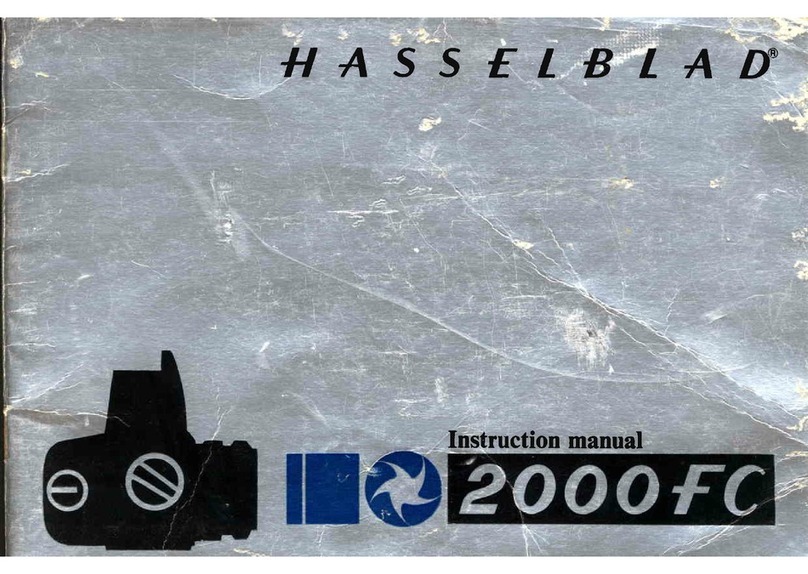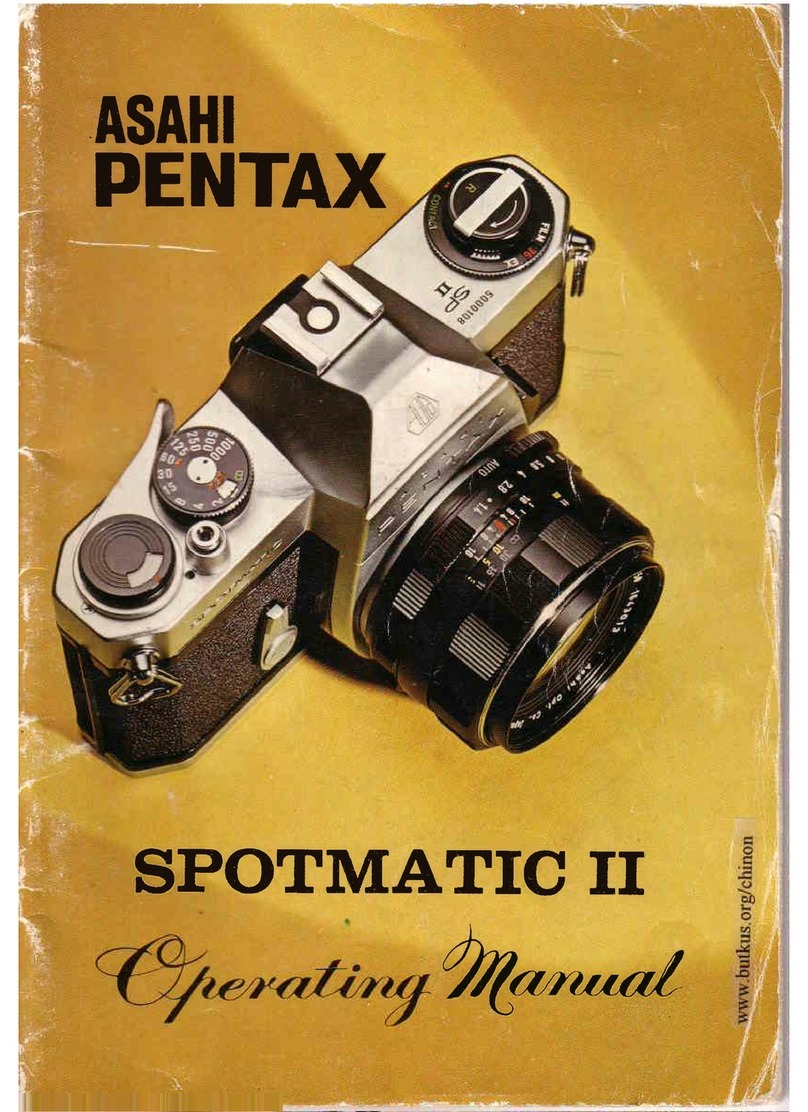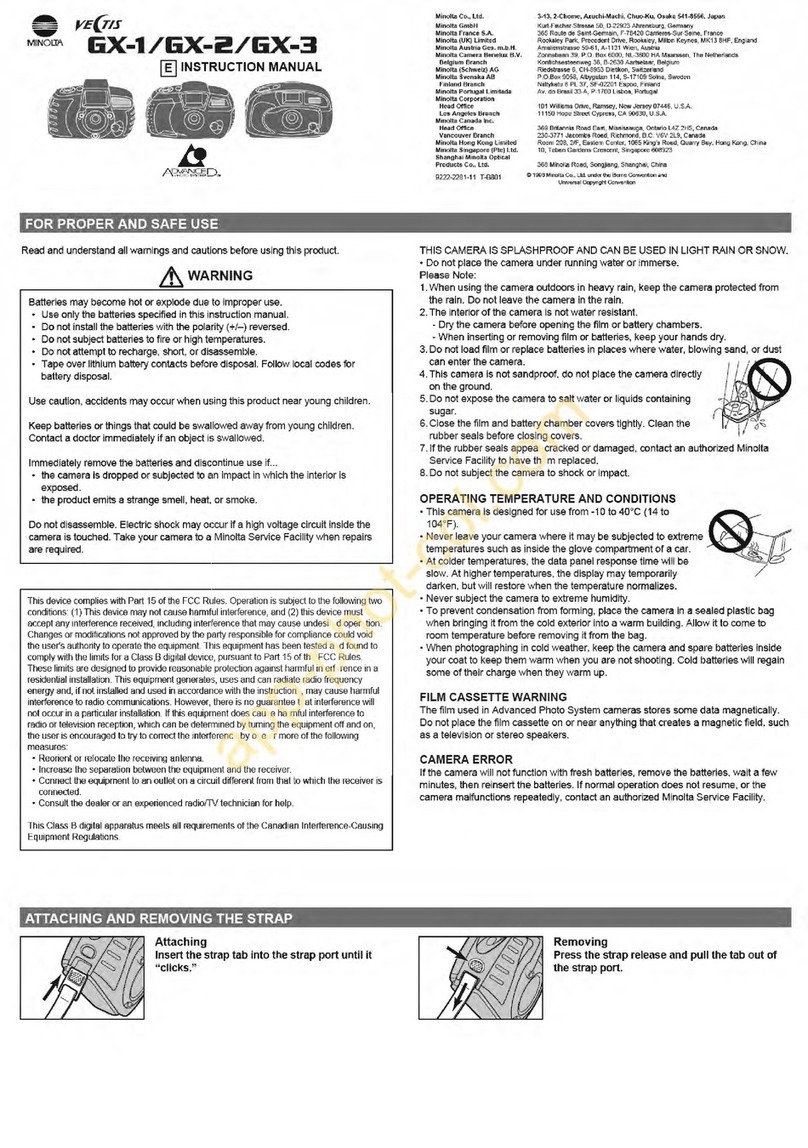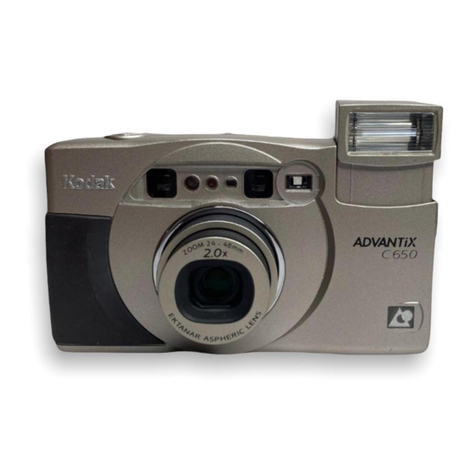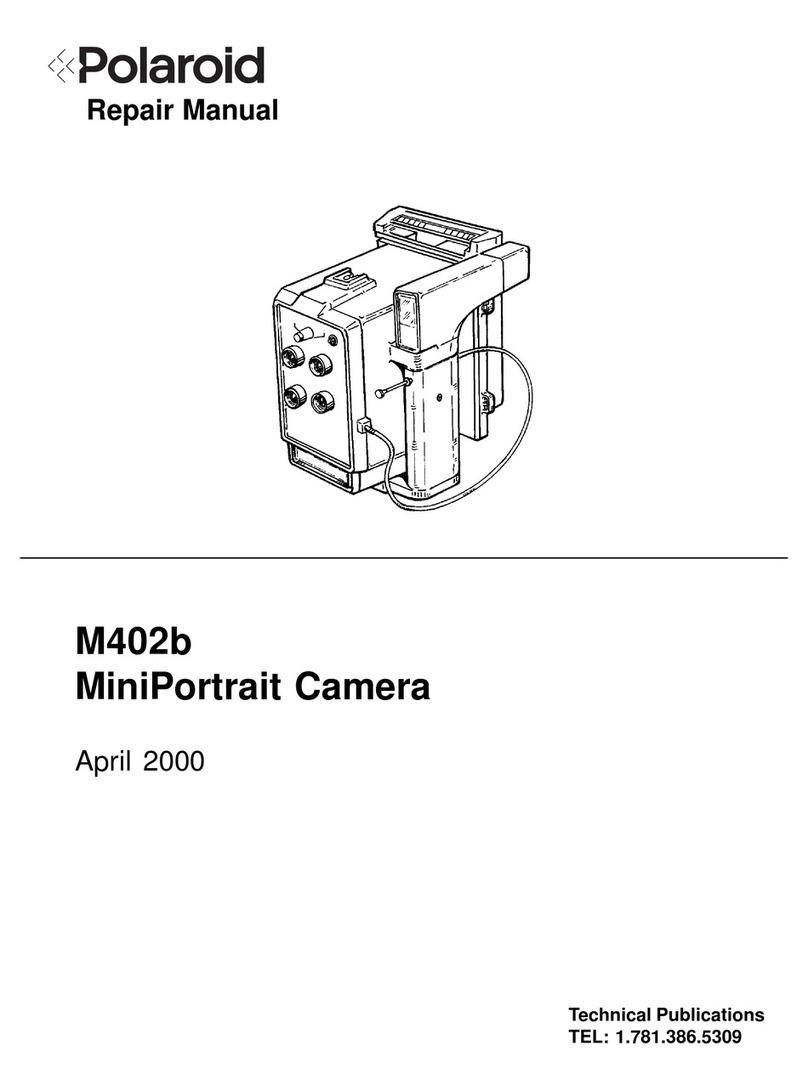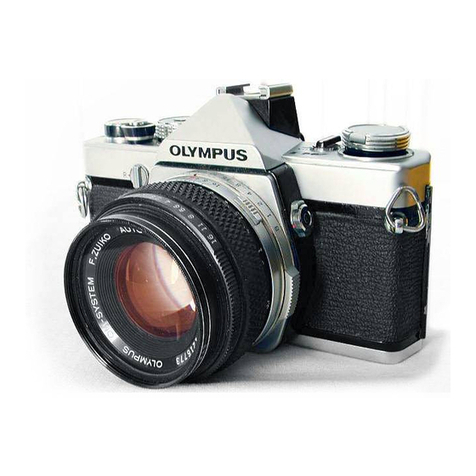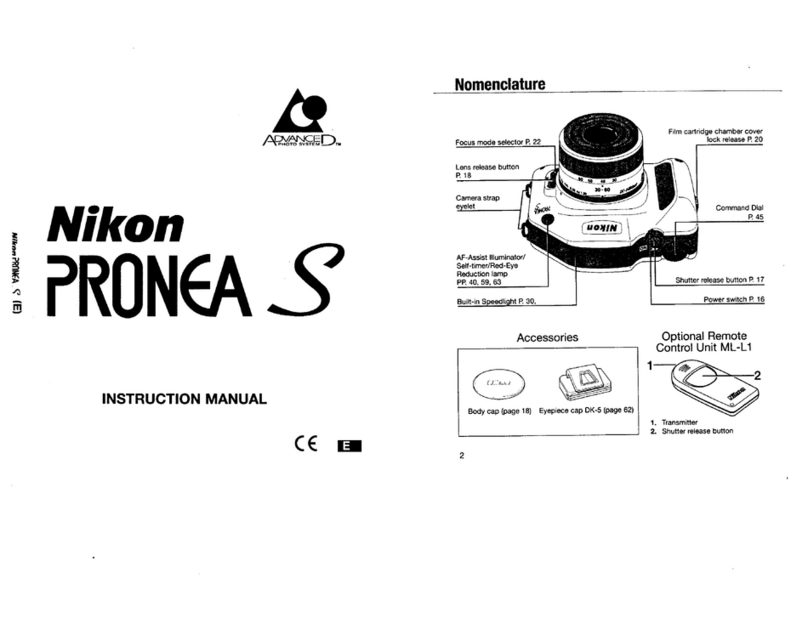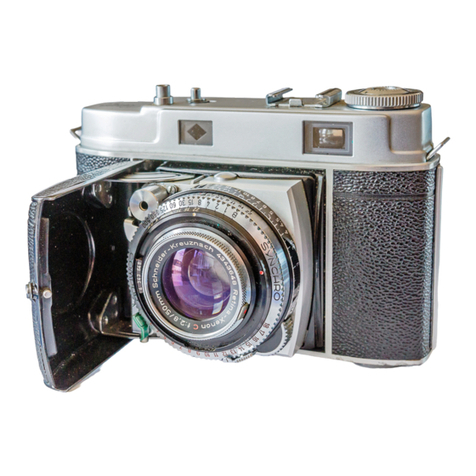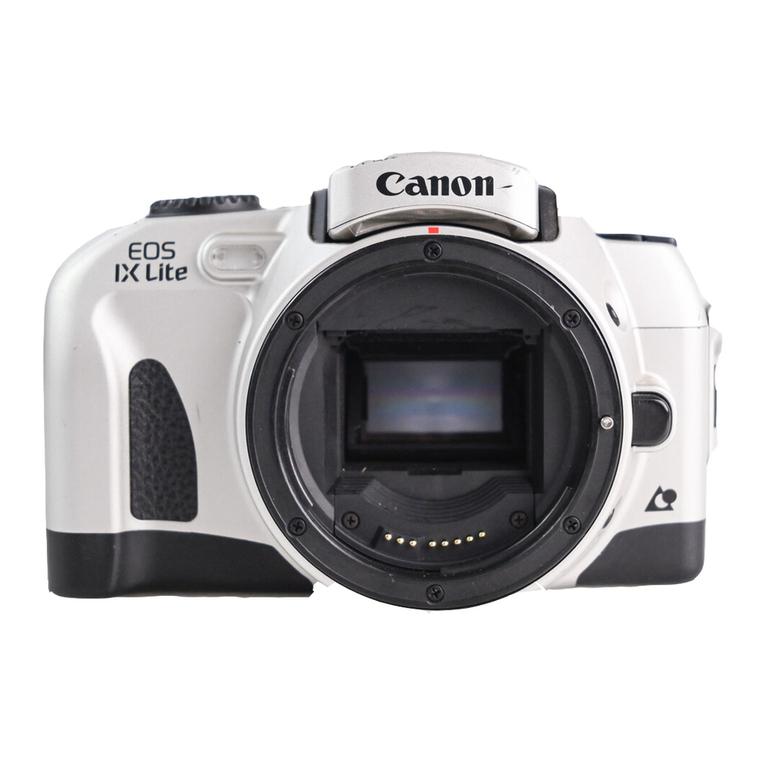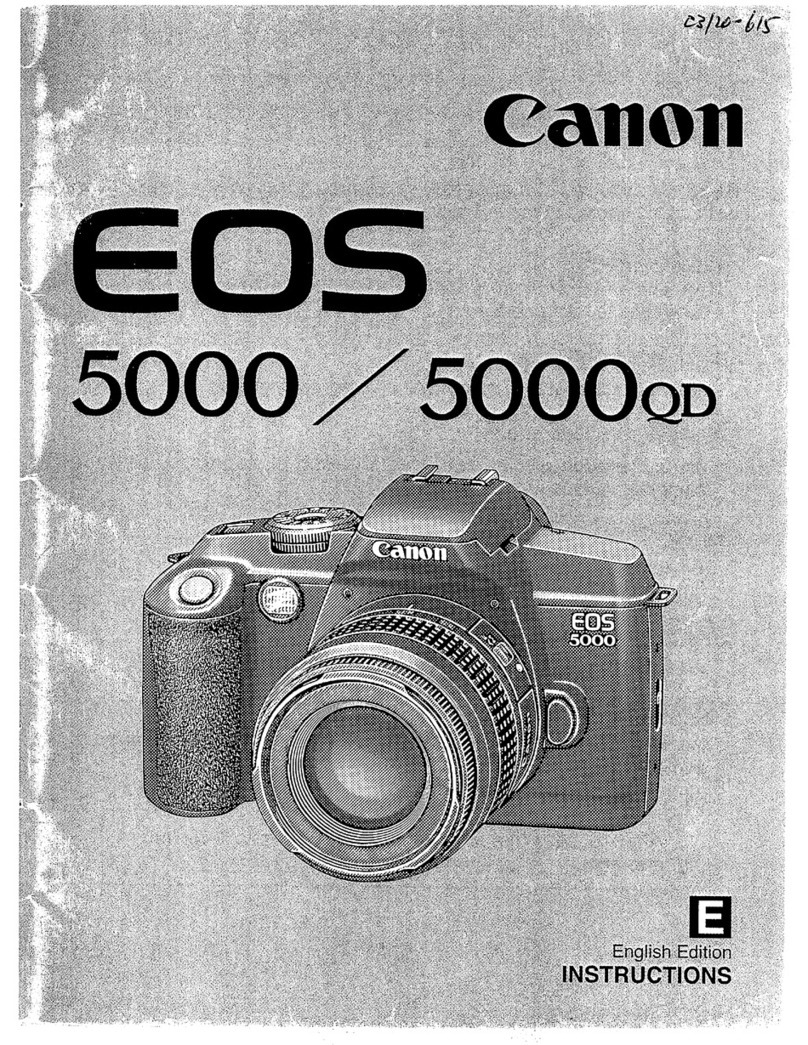CHINON M-1 User manual

Donated to www.orphancameras.com

FEATURE IDENTIFICATION CHART
2
,Accessory shoe wIth dorect
flash
contact
<
Shutter
speed d.al
.,
Film speed d,al
ASA
DIN
I
Film
advance lever
Shutter
release
"
MultIple
exposure lever
;Exposure
counter
wIndow
Shoulder
strap
eyelet
II
Exposur
meter
sWItch
•Self
time,
10
F
stop
ring
11
Depth
of
fIeld scale
IDIstance
ring
" M synchro flash socket
, X synchro flash socket
,F,lm type IndIcator
"FIlm rewind knob Film
chamber
cover openlnll
,
Battery
test
button
Donated to www.orphancameras.com

"Viewfinder eyepiece
Battery
test
light
"
Film
chamber
l2
F,lm guide ra,l
CdS
battery
compartment
cover
_.
FIlm ra,l
Tropod socket
Shutter
rt
Rew,nd
button
_Take up spool
FIlm pressure
plate
Film
chamber cover
J1
Sprocket teeth
3
Donated to www.orphancameras.com

IMPORTANT I
BASIC STEPS
IN
PHOTOGRAPHING
11
Insert
CdS
battery with plus
( ) side
up
I
Fig.
31.
21
To
test battery condition,
depress the battery test
button
and
observe test light
,Fig.
41.
3load 35 mm film
In
20 or 36
exposure cassette (Fig.
51.
41
Set
ASA
lor
DIN
I
speed
dial
In
accordance with the film
speed
specified
on
the film
box
(Fig.
61.
,51
Set
either
the
shutter
speed
or lens opening according to
your photographic
need
(Fig.
7l.
161
Focus
the lens
(Fig.
81.
1]1
Release
the shutter
(Fig.
81.
fI16
~
fll
7
f'l.
a
Donated to www.orphancameras.com

LOADING THE CAMERA
Use
35
mm
f,lm
on
20
or
36
exposure cassette
It
is recommended
to
load and
unload
camera
on
subdued
light.
eg
shadow
of
your
own body
and
not
in
direct
sunlight.
1Pull
up
folm
rewind knob untol camera back
pops open
Swong
open camera back Fig
9
2While rewind knob
oS
st,lI
fully
pull dup
onsert
folm
cas
ett
onto
chamber
woth
pro
truding
end
toward
bottom
of
camera Press
in
folm
rewind knob
If
it
does
not
go ,n
F
••
10
all
the way
turn
ot
untol
ot
does
3Insert nd
of
film
~nto
slot
on
take
up
spool
and engage
perforat.on
of
101m
woth
tooth
In
spool
slot
Place
thumb
lightly
ov r
101m
on
bottom
sprocket wheel and operate
101m
advance lever unt.1 upper sprocket wh I
engages
folm
perforatIons. When advance
lever stops. free
ot
by depressing
shutter
release on top
of
camera Make sure
that
folm
lies
flat
between guide rails Fig.
10
Close camera back
f"mly.
5
Donated to www.orphancameras.com

Fl.
II
4Operate
film
advance lever, depressing
shutter
rlease unt" figure
"1"
'5 lined
up
,n the exposure
counter
window In
this
position
the
camera
15
ready
for
the
first
exposure
to
be
made
Fig.
11
,
To be
certain
that
the
film
transports
cor
reclly, take up any
101m
slack in
the
cassette
by
turning
the re,wlnd
crank
clockwise
till
resistance
15
felt. When advancing
the
film
the rewind knob should
turn
antlclockwlse
ThIS
15
evidence
that
the
film
is
loaded
correctly
If It
does
not.
start
loading
again
6
Fl.
12
SETTING FILM
SPEED
(ASA DIN)
The
ASA
or
DIN speed
of
the
f,lm
.sspec,f,ed
on the
f"m
box
or
In the
Instruction
sheet
packed
with
the
101m.
Pull
up
and
rotate
the
outer
rim
of
the
shutler
dial
until
desired
ASA
DIN
number
of
the
101m
appears In the window
on
the
top
of
the
film
shutter
speed dial Fig.
12
Donated to www.orphancameras.com

Fl.
14
CORECT
EXPOSURE
Correct exposure can be made by settong F
stops on the lens and correct combination
of
shutter
speed.
As
the CHINON
M1
camera
has abUilt in through
the
lens
CdS
exposure
meter. you can take
correctly
exposed photo
graphs
1
See
the subject through viewfInder Press
down the exposure
meter
switch Fig.
14
DependIng upon the subject.
rotate
either
shutter
speed dIal
or
Fstop ring
until
the
7
71
It
11
U
IS
"
..
n
a"
"
'I
~
I.
II
"
"
•
,......
n
I' I'
.........
1»
•
..
• "
II
..-...............
ASA
...
DIN
..
Fl.
13
Also
rotate
fIlm type
Indicator
dial
so
that
the
film
type inserted shows
to
Its
pointer
Fig.
13
.
This will remind you
of
the
type
of
101m
you
are using.
Some
ASA
DIN numbers are represented by
a
dot
only The
chart
below specifIes the
ASA
DIN numbers
Donated to www.orphancameras.com

8
Fi,.
15
Fi,
17
exposure
Indicator
needle in the viewfinder
comes
to
the complete horizontal position
Fill.
15.
If
the needle is above the hori·
zontal position,
it
Is
overexposed Fill.
16.
Chanlle the
shutler
speed
to
afaster speed
or
use asmaller lens openinll so
that
the
correct exposure combination can be ob
tained. If the needle
is
below the horizontal,
it
is under exposed so
that
aslower
shutler
Fi,
16
1
Fi,
18
speed
or
biller
lens openinll
must
be set
Fill. 17 .
2When the
Iillht
level is too low and you are
unable
to
obtain the correct exposure com
blnation as stated above, the red warnIna
sillnal will appear in the exposure indlcat·
inll
zone in the viewfinder Fill.
18,.
When the red
warninll
sillnal appears with
needle in position, use aflash unit.
Donated to www.orphancameras.com

In
focus
oUl
of
focus
F'll 19
FOCUSING
Rei
ase
th exposure
meter
switch and slid
AUTO MANUAL control on the lens to Auto
poslt,on Fig.
19.
Turn th d,stance ring
first
,n
one dlrect,on.
then in the opposite direction unt,l microprosm
d,sc in the centre
of
the
image In the
VIew
f.nder
IS
sharp Fig.
20.
P,cture
IS
now focused
The d.stance scale
may
also be used
for
focus
Ina EstImate
or
measure the camera
to
sub
lect
dIstance in feet
or
in
metres. then
turn
the
focusIna rlng.
So
the fiaure represent,na
that
dIstance
IS
opposIte
the
ondex
lone.
9
Donated to www.orphancameras.com

RELEASING THE SHUTTER
Hold
the
camera
as
ste
dy
as
possIble and
press the
shutter
release slowly and smoothly.
When using slower
sp
ds rangmg
Irom
1
30
to
1second and
"B"
bulb ,n poorly
lot
areas.
use atripod
or
other
lorm support
to
prevent
blurrong the picture.
10
SETTING THE SHUTTER
The length
01
t,m
lor
the
"1m
to
be
exposed
to
Ioght can
be
adjusted by
shutter
speed
set
ting.
"60"
1
60
second
IS
recommended
lor
subjects
not
,n motIon
It
's recommended
to
use
shutter
speeds rang
mil
Irom
1
125
to
1
1000
lor
subjects m
mo
tion. 1
1000
second speed will best
"Ireeze"
last
action
The"
B"
sett,ng can
be
used
lor
long exposures
at
n,ght. uSlnll street Ioghts
or
electric s'lIns,
or
und rpoor Iollht condItIons when flash
un,t
's
not
used
Donated to www.orphancameras.com

Fl.
21
Fl.
22
UNLOADING
THE
CAMERA
When the red
figure"
20"
or"
36"
correspond
ing
to
20
and
36
exposure
film
appears in the
exposure counter window lined up
to
the
index
mark.
the
end
of
the
film
has been reached.
Take the following steps for rewinding
film
Into
cassette'
1Unfold
crank
on rewind knob Fig. 21 .
2Press in all the way rewind release
button
on camera
bottom
Fig.
22
..
3Turn rewind
crank
lever clockwise. Tension
,s
relt
as
the f,lm Is rewound from
the
take
up spool
Into
the
cassette Stop rewind
'ng
when tension Is released. Open camera
back by pulling
out
rewind knob all the
way and remove
the
film.
Have
film
processed
without
delay.
11
Donated to www.orphancameras.com

12
Fl'
23
DEPTH
OF
FIELD
Azone
of
the pIcture In
front
of
and behInd
your
subject wIll also be sharp. The
depth
of
thIs zone dpends on the aperture selected
If
you wIsh
to
know how much
of
an area w,lI be
sharp
,n
th
fInal picture.
It
can
be predeter
mined ,n
two
ways
IA)
Depth
of
Field
Prevlewer
Slide the AUTO MANUAL
aperture
openIng
sWItch
to
..
M"
Manual posItIon
set
the
lens
to
the selected aperture opentng
of
the Fstop
ring
ThIs
WIll
enable you
to
prevIew the area
of
sharpness In the pIcture
before takIng.
IBI
Depth
of
Field
Scale
Fig.
23
After
setting
the lens opening and haVIng
focused on your subject,
the
area
of
sharp
ness ,n
front
of and b
hind
your
subject
can be determined
on
the
Depth
of
FIeld
SCale
Locate on
the
Depth
of
Field
SCale
the
same
two
Fnumbers correspond,ng
to
stop you have set
on
the F
stop
ring. The
dIstance between these
two
Fnumbers on
the
fOCUSIng
scale
WIll
be
the
area
of
sharpness In your
picture
Donated to www.orphancameras.com

Fl.
24
Fl.
25
SELF TIMER
The self
timer
permits
the photographer
to
get
Into
the
pIcture Place camera on trIpod
or
other
form
support trIpod socket
IS
on
bottom
of
camera G t camera ready
for
exposure as
usual. Push down
If
tIm
rlever FIll
24
Depress
shutter
release
to
start
self
tImer
Ex
posure
WIll
be
mad
approxImately 8seconds
after
th
release has been pressed
FLASH PICTURES
Most types
of
flash bulbs and also electronIc
flash can
be
used for flash pIctures
When uSlnll flash bulb No 5.
58
25.
258.
M5.
M58. M2.
M28.
AG
I.
6.
68.
8. connect flash
cord
to
flash socket
..
M'
When uSlnll ele
ctronlc flash
or
SM
flash bulb, connect
the
flash
cord
to
flash socket
..
X.. FIg
25
The use
01
Nos. 5.
58.
M5
and
M58
flash bulbs
as well as electronIc flash Nos. 6.
68.
8flash
bulb
IS
recommended
for
shutter
speeds from
1
30
to
1
125
sec.
The use
of
Nos M2.
M28.
AGI.
AG18
SM
flash
bulbs
IS
recommend dfor
shutter
speeds from
13
Donated to www.orphancameras.com

1
30
to
1
60
sec. Cordless lIash
units
are
slipped
into
the
accessory shoe on the top
of
the
camera. The accessory shoe
may
also
be
utilized
for
aflash
unit
having asynchro cord.
MULTIPLE EXPOSURE
To superimpose
two
or
more exposures on one
negative. support the camera on arigid tropod
to
ensure correct
framing.
Make the
first
ex
posure
in
the
normal
way, then, WIthout movIng
film
transport
lever, slide the
multiple
exposure
lever Fig.
26
as
far as
It
WIll
go
to
the
left
Ared signal appears
,n
ItS
cutout
window In
dlcatlng
that
the
film
transport
lever can
be
wound.
but
WIll
only
set
the
shutter
and
not
transport
the
film
On releaSing, asecond
ex
posure is made on
the
same f,lm frame This
procedure can be repeated
to
obtain any
num
ber
of
exposures on one negat,ve If the
multiple
exposure lever has been set
but
is in
fact
not
required. you can
manualiy
push
It
back
to
cancel
its
effect.
14
CHANGING THE
LENS
A
55
mm
lens is the proper focal length
tor
general purpose picture taking. Any Ch,non
telephoto and wide angle lens
or
Pentax. Prinz·
lIex
or
Sigma lens
mount
can be used. To
remove the lens, push up the exposure sWItch
on the camera body, holdIng
It
in one hand and
grop
the lens WIth the other,
turning
counter
clockWIse
until
It
's removed
To replace the lens,
turn
clockwise
until
secured
in position fInger
tight
Fla
26
Donated to www.orphancameras.com

MEMO
Donated to www.orphancameras.com

•
PRINTED IN JAPAN SA7345000
Donated to www.orphancameras.com
Table of contents
Other CHINON Film Camera manuals


